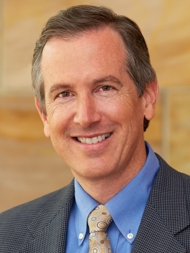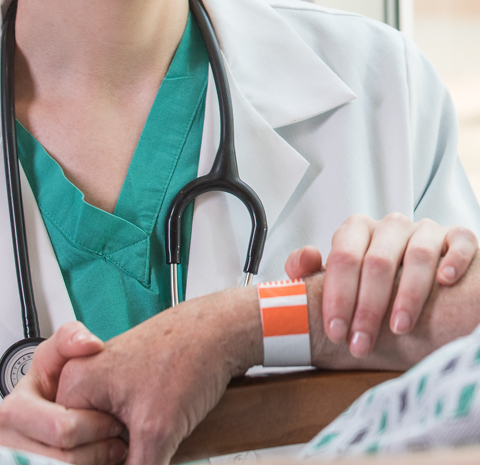For the first time ever in New Mexico, doctors at The University of New Mexico Comprehensive Cancer Center have treated blood cancer patients by transplanting cells from a donor.
Late last year, Matthew Fero, MD, FACP, and the Stem Cell and Bone Marrow Transplant team at UNM Comprehensive Cancer Center completed the first procedure, known as an allogeneic stem cell transplant. The first patients successfully completed their 90- to 100-day checkup, which is an important milestone in stem cell transplantation treatment.
“The patients completed their check-ups with flying colors,” says Fero. “The ability to conduct allogeneic transplantation fills a large gap that previously existed in the care of patients with blood cancers in New Mexico. Together, with other advanced therapies at UNM, we should be able to treat nearly every type of [blood] disease.”
Allogeneic stem cell transplants are an approach to treating leukemia, and other cancers of the blood. Transplants aim to cure the disease, using blood and bone marrow stem cells from a donor.

The patient receives an entirely new immune system that can attack the tumor cells and help to eradicate the remaining bits of residual disease. This immune response decreases the risk of the disease coming back.
In the procedure, patients begin with chemotherapy that, along with destroying the cancer cells in their bloodstream, also strips away other blood-forming cells. Blood and bone marrow stem cells are then collected from a donor and infused into the patient to jump-start the process of rebuilding the immune system.
The procedures take time, and patients often need to stay in the hospital for several weeks because of their vulnerability to infection. After they are released from the hospital, they still have to stay near the transplant center for several more months to make sure their bodies don’t reject the transplanted stem cells.
“Because of family obligations it would have been a tremendous hardship for our patients to travel out of state,” says Fero. “We were happy to be able to provide this treatment and let our first patient return to his own home immediately after being released from the hospital.”
Until last year, the stem cell transplants performed at the UNM Cancer Center had been autologous transplants.
In autologous transplants, the patient’s own stem cells are coaxed into the bloodstream, harvested and frozen before the chemotherapy treatment. After chemotherapy, the stem cells are carefully thawed and injected back into the patient’s body, where they migrate to the bone marrow and regrow the immune system.
Allogeneic transplants differ from autologous transplants in that stem cells are harvested from a donor. The procedure is used to treat certain blood cancers when an autologous transplant isn’t as helpful.
”Using bone marrow stem cells from a donor ensures that they will not be contaminated with leukemia cells — like they might be if they were harvested from the patient,” says Fero. “But this is not the only benefit. The patient receives an entirely new immune system that can attack the tumor cells and help to eradicate the remaining bits of residual disease. This immune response decreases the risk of the disease coming back.”
In allogeneic transplants, because the stem cells do not come from the patient, the immune system markers must be carefully tested. Donors are matched according to their immune systems’ unique “barcode” in a process called Human Leukocyte Antigen typing, or HLA typing.
HLA typing goes much deeper than evaluating a standard blood type: it identifies the exact HLA markers found on our bodies' cells, from over a million different possible combinations. The immune system relies on these markers to determine which cells belong in the body, and which to fight to stave off infections.
Fero describes another major advance in the field of stem cell transplantation: the ability to use donors whose HLA type is only half-matched.
“The availability of these haploidentical transplants greatly increases the opportunity of New Mexicans to access this therapy,” Fero says. “While there is only a 25% chance that a brother or sister is fully matched, 50% of siblings and 100% of children and parents are haploidentical.”
Fero explains that haploidentical transplants make treatment possible for many New Mexican patients, who because of their rich and mixed ancestry, might not find matched donors in the registries of unrelated donors.
"We recently completed a haploidentical transplant from a young woman with relapsed leukemia, and are thrilled about how well she has done," Fero says.
Until now, New Mexicans had to travel out of state and live away for months when their treatment plan called for an allogeneic stem cell transplant. With the new allogeneic capability at UNM Cancer Center, they don’t have to.
UNM Comprehensive Cancer Center
The University of New Mexico Comprehensive Cancer Center is the Official Cancer Center of New Mexico and the only National Cancer Institute-designated Cancer Center in a 500-mile radius.
Its more than 136 board-certified oncology specialty physicians include cancer surgeons in every specialty (abdominal, thoracic, bone and soft tissue, neurosurgery, genitourinary, gynecology, and head and neck cancers), adult and pediatric hematologists/medical oncologists, gynecologic oncologists, and radiation oncologists. They, along with more than 600 other cancer healthcare professionals (nurses, pharmacists, nutritionists, navigators, psychologists and social workers), provide treatment to 65% of New Mexico’s cancer patients from all across the state and partner with community health systems statewide to provide cancer care closer to home. They treated almost 15,000 patients in more than 100,000 ambulatory clinic visits in addition to in-patient hospitalizations at UNM Hospital.
A total of nearly 1,855 patients participated in cancer clinical trials testing new cancer treatments that include tests of novel cancer prevention strategies and cancer genome sequencing.
The more than 123 cancer research scientists affiliated with the UNMCCC were awarded $38.2 million in federal and private grants and contracts for cancer research projects. Since 2015, they have published nearly 1000 manuscripts, and promoting economic development, they filed 136 new patents and launched 10 new biotechnology start-up companies.
Finally, the physicians, scientists and staff have provided education and training experiences to more than 500 high school, undergraduate, graduate, and postdoctoral fellowship students in cancer research and cancer health care delivery.
